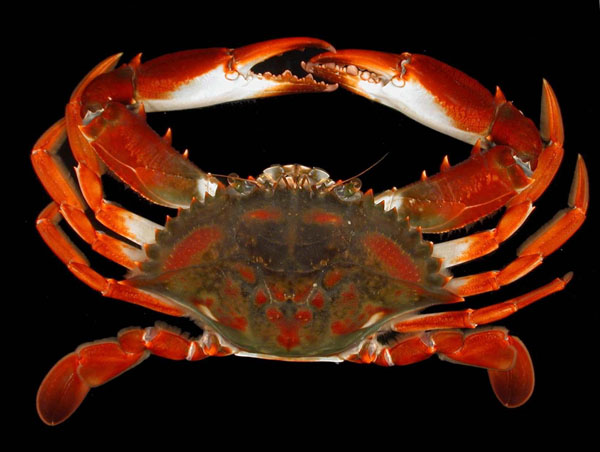In early November a local crabber, Kevin Martina, brought an interesting catch to the Franklin County Extension office in Apalachicola. Kevin and his brother Kenneth Martina fish for blue crabs in Apalachicola Bay and they came across what appeared at first glance to be a red-colored blue crab. In all their combined years of working crab pots, neither of them had seen a crab like this. On closer inspection at the Extension Office, there appeared to be some differences from a blue crab, other than the striking red coloration. It was the innate curiosity of our Extension Office Manager, Michelle Huber, that led us to the discovery that the crab was a species with a native range spanning Jamaica and Belize to Santa Caterina, Brazil. After Michelle showed photos of what she had found on her phone, we reached out to colleagues at the Apalachicola National Estuarine Research Reserve (ANERR) and told them we might have a Bocourt swimming crab (Callinectes bocourti). I told them that I could find no range maps indicating this species lived in our region. The nearest US Geological Survey data points for the species in the Gulf of Mexico were Alabama to the West and the Florida Everglades to the South. It was not long after the ANERR staff reached out to the Fish and Wildlife Conservation Commission that we received interest in confirming the identification and officially documenting the Bocourt swimming crab find.
The first documented occurrence of a Bocourt swimming crab in the US happened in 1950 in South Florida. Since then, there have been rare finds in AL and MS and more common occurrences from South Florida all the way up to North Carolina on the Atlantic Coast. Theories about how they arrived include possible transport of larvae in ships’ ballast water or a natural expansion of range with the aid of various ocean currents like the Gulf Stream or by hitching a ride on floating debris from the Caribbean. Ecologically speaking, Bocourt crabs and our native blue crabs have virtually the same dietary habits and both species occur together throughout some parts of their native range. Even though there is likely some competition for food and refuge habitat, it doesn’t appear at this time that one of these crabs would dominate the ecosystem over the other. It also is not evident that Bocourt crabs are reproducing and established in the Northern Gulf of Mexico to-date.
If you are a commercial crabber in the Florida Panhandle, or happen to fish a few recreational traps, we would be interested to know if you have seen this species before. Location data and any good photos of specimens would go a long way to help monitor the species occurrence in our region. You can reach out to me at Elovestrand@ufl.edu or contact your local County Extension office to pass the info my way. Happy crabbing!
- Recent Catch of a Bocourt Swimming Crab in Apalachicola Bay - November 22, 2024
- Damselfly Love - October 18, 2024
- Meet the Ocellated Flounder - June 28, 2024

